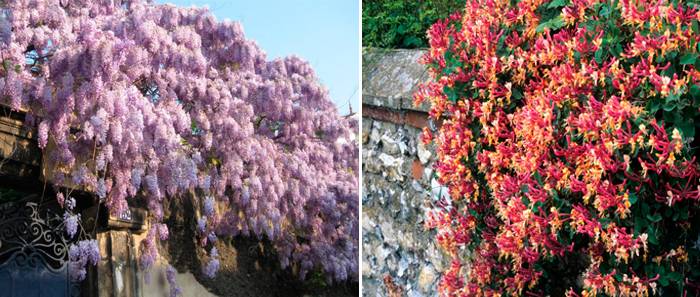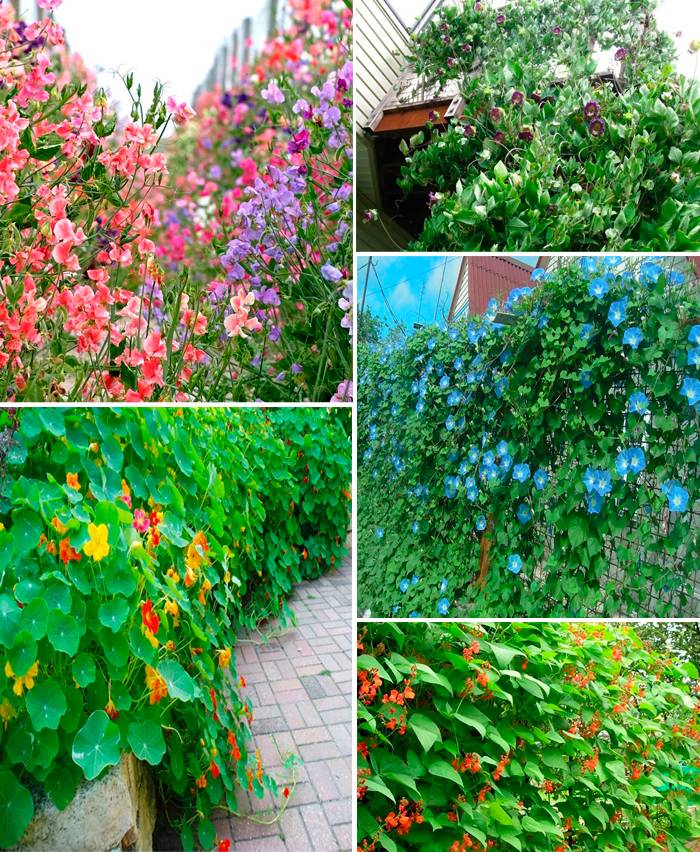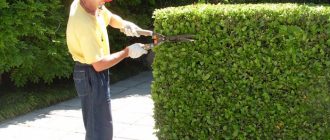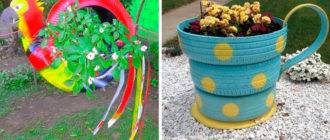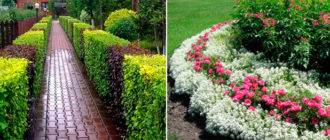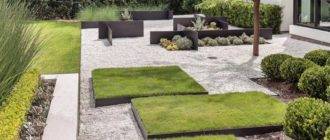In landscape design, curly green hedges are traditionally used. Thanks to such plants, you can not only decorate your personal plot, but also decorate an old fence, while perfectly saving your money. They are excellent at compacting mesh hedges, turning the netting into a green carpet. Bushes planted near unprepossessing buildings, compost heaps transform the garden, ennoble its appearance.
If you need to hide something from prying eyes, vines are the best way out. If you want to do gardening, I offer a small "guide" to the virtual garden. Imagine that it is planted with vines - flowering, evergreen, deciduous.
Most often, curly flowers are used for gardening fences, which do not require regular maintenance. Often perennials that grow annually are used for this. However, if you do not want the fences to be too shrouded in loaches, then annual vines will come to the rescue, which you can change every year depending on your mood.
Curly annuals
Hedges covered with bright buds are a dream come true!
Annuals are more capricious than perennial vines, they do not have a dense crown, but numerous buds delight.
Types of plants used for climbing hedges:
- sweet peas are recognizable by funnel-shaped fragrant buds;
- decorative beans form bright red or orange clusters of inflorescences;
- kobeya - a waterfall of delicate white or blue-violet bells;
- morning glory - a fast-growing liana, not demanding to care, strewn with colored phonographs;
- nasturtium is distinguished by decorative foliage, yellow or bright orange bell-shaped buds.
All these plants are used for decorating facades, arranging shady gazebos for relaxation. In the presence of support as delimiters of various zones.
Blooming climbing perennials
Winter-hardy crops are used for vertical gardening, hedges, imitation of fences when zoning a site. I advise you to choose unpretentious vines, with regular fertilization, they strike with lush covers, give a quick increase. Many retain their decorative effect until late autumn, the colored fruits complement the autumn crown, which changes colors when it gets cold.

Honeysuckle
Among the species diversity, only a few varieties form long lashes that tolerate the garter well to trellises, walls, and netting. Liana honeysuckle prefer fertile soil, good lighting, regular application of organic matter and trace elements. Plants are best purchased from local nurseries, they specialize in zoned varieties adapted to weather conditions.
Some types of honeysuckle that are effectively used for hedges:
- Honeysuckle is a liana-like deciduous plant with showy yellow-white flowers with a reddish tint and inedible red or orange berries. It grows up to 6 m. It is unpretentious, grows well and tolerates formative pruning.
- American bred by crossing with honeysuckle and Tuscan honeysuckle. The yellow-purple inflorescences are very fragrant. Afraid of the northern cold wind, frost. For the winter, the branches are removed from the trellises, covered. The berries are bright red, inedible.
- Brown fuchsia is a hybrid of two types of honeysuckle: evergreen and rough. White, yellow, creamy buds in the form of expanding tubes are collected in a small sultan. The fruits are gray.
- Brown's Dropmore Scarlet is another hybrid with bright red clusters of narrow tubular flowers. Curly shoots up to 5 meters long. Carmine buds with a white-creamy core have a strong aroma that intensifies in the evening. Fruits are red, persist until frost.
- Serotin's late honeysuckle is not very long - up to 3 meters, dark red inflorescences fade by the stage of berry tying, become pale pink. Blooms from June to mid-August. The fruits are red. It is prone to freezing, it is sheltered for the winter.
There are many more species and varieties of this beautiful plant.
Remember that curly honeysuckles with red, orange, rarely black berries are not edible.
Climbing rose
Pleases with fragrant buds from late May to mid-July. Heat-loving, demanding on lighting, feeding, watering, pruning (remove all fading flowers). Grows well in neutral, drained soil, susceptible to root rot.

Clematis
Liana forming cascades of buds. Bred varieties with single-row double flowers of pink, white, blue, light purple color. During the flowering period, it is advisable to water the plant regularly, loosen it. For the winter, the shoots are cut to 2/3 of the height, the soil is insulated with mulching or covered.
Petiolate hydrangea
Rare, but such a picturesque shrub! Owners of fragrant snow-white hydrangeas with dark green leaves will never be disappointed. Bushes are often placed along stone walls, the thermophilic liana loves to bask in the sun, and is demanding of watering. Winters calmly in mid-latitudes. Only in winters with little snow does it freeze a little.

Schisandra chinensis
I cannot ignore this common type of hedge. Edible red fruits have medicinal properties, curly leaves are added to tea for flavor. Lemongrass does not like stagnant water, it develops poorly on poor soil. Responds gratefully to pruning.
Wisteria
Delicate lilac inflorescences, resembling grape bunches in shape, continue to bloom all summer. The seedlings are transferred to a permanent place in early spring, at a great distance from each other. The liana gives a good annual growth, the branches are immediately fixed so that they do not bend under the weight of the flowers.
The plant is sun-loving, grows well in fertile soil. Top dressing must be applied three times per season. Formative pruning is carried out in the fall, in the spring you can cut the shoots with flower buds. A month before wintering, the plant is allowed to rest, for the period of cold weather it is removed from the trellises, covered.
Evergreen and deciduous perennial vines
For shady corners of the garden, you need unpretentious plants that form a green mass. On my site, an openwork welded arbor is braided by wild hops brought from the forest. Frankly, I'm tired of fighting him. The roots spread out in different directions. Neighbors prefer more noble plants, I give a description of some liana crops that deserve attention.
Ivy
In European countries, an evergreen shrub reaches 30 meters in height. In temperate latitudes, such splendor cannot be achieved. But 5-6 meters is quite an achievable height. 2-3-year-old seedlings take root well. It is better to plant them in the spring in the soil filled with organic matter. In summer, ivy is pruned, sometimes the shoots freeze slightly. It is worse when the root system suffers from frost. For the winter, the soil on the plantings is mulched, a layer of up to 15 cm is created. In winter, it is advisable to carry out snow-holding measures.

Fortune's eonymus
Of all the varieties of creeping shrub for trellis cultivation, Emerald Gold is best suited. Oval green leaves with a light yellowish border acquire a rich brownish-red color in the fall. On too shady areas, the motley border of the leaves disappears, they become monochromatic. The culture is valued for its green cover, but in spring the euonymus pleases with numerous buds. Flowering will be plentiful if complex fertilizers are applied annually to the soil, if sunlight is given access to the liana.
Maiden grapes
It is advisable to plant it on the leeward side, in a sunny area. Curly large leaves, loose bunches of berries adorn the garden in summer.At the first frost, the foliage begins to turn red, acquiring a purple hue. Young bushes are demanding watering. Mature plants are less whimsical. For the winter, plantings are thrown with branches and dry grass. Some gardeners strengthen dense acrylic over the plantings. The culture rarely freezes, but it is prone to damping off in areas of spring flooding. In the planting holes, it is advisable to do a 20 cm drain.
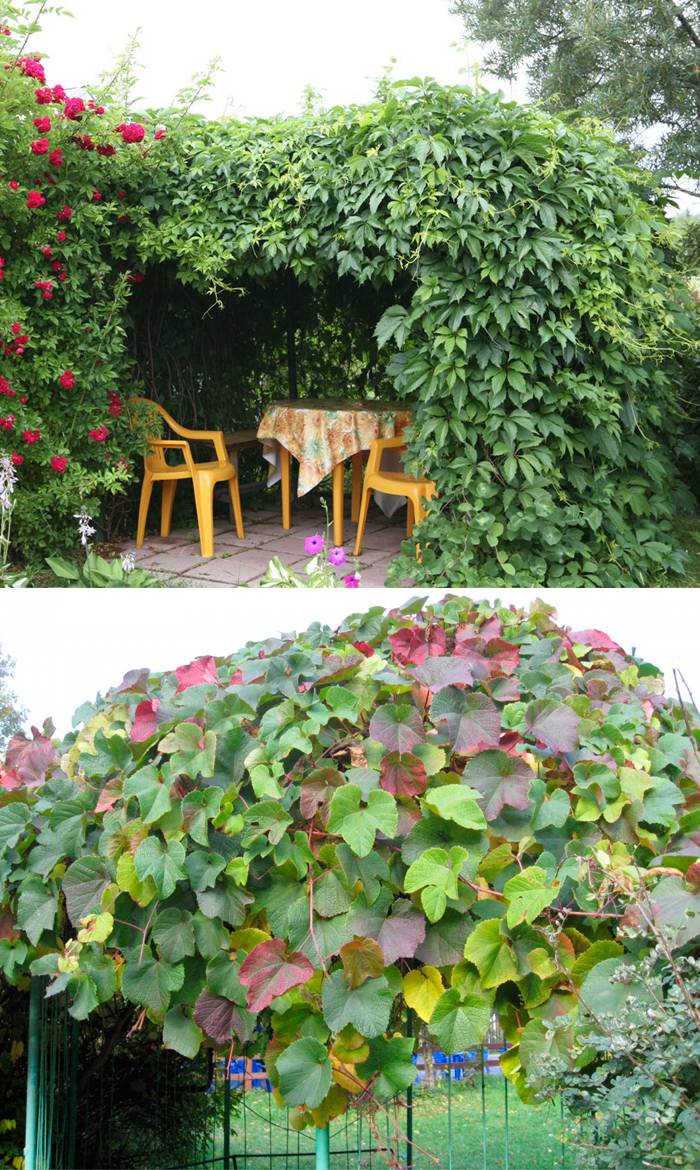
Amur grapes
If you want to get "two in one", plant the garden with this winter-hardy vine. In addition to the chic crown, get bunches of round purple edible berries. During aging, they look decorative. With a decrease in temperature, a reddish-brown pigment prevails in the leaf plates.
The plant is unpretentious to the soil, it requires nitrogen-phosphorus fertilizers, potassium is applied only during the period of waxy ripeness of berries. Excess calcium inhibits Amur grapes, it develops worse.
Woodlip
Liana climbs the walls with rigid hooks. It grows into softwood, slate. It is best planted against brickwork. Shiny leathery leaves the size of a hen's egg form a dense crown. In the spring, white flower caps appear on the bush. In autumn, bright red berries ripen from them, they look advantageous against the background of yellowed foliage.
For full growth, the culture is fertilized three times a season with organic matter and mineral complex fertilizers for flowers. For the winter, it is enough to cover the roots, they are mulched with peat, covered with a layer of straw, dried shavings, spruce branches - it keeps snow well. With good care, the vine grows by 2 meters.

Periwinkle
Unpretentious to soil, light, moisture. It grows beautifully in the shade, however, it does not bloom so abundantly with white or red flowers. If you need to disguise the shaded facade of the building, it is better to choose low grades, the vine will not have to be closed for the winter. It adapts to all conditions. Large varieties have variegated foliage with yellowish or white veins. This ornamental plant will need a winter shelter. Do not be alarmed if in the spring you find frozen shoots, the periwinkle grows quickly.
An ugly fence or an old wall can really ruin the whole impression of a well-kept garden. But fortunately, this can be fixed with loaches, which can give the landscape additional structure and become a great natural backdrop on your site.
My little guide to the best vines for a climbing hedge is complete. I would be glad if a picturesque green fence or an arch entwined with whips appears on your site.
Do you camouflage your garden fence? What vines do you prefer to plant? Share with us in the comments.

